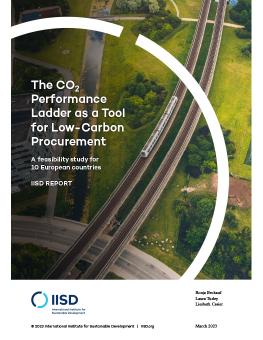
The CO2 Performance Ladder as a Tool for Low-Carbon Procurement
A Feasibility Study for 10 European Countries
This report assesses the feasibility of using the CO2 Performance Ladder—a green public procurement tool used extensively in the Netherlands—in other European contexts. It provides an overview of how the tool can be implemented in 10 European countries: Austria, Denmark, Germany, Ireland, Italy, Poland, Slovenia, Spain, Sweden, and the United Kingdom. Widespread low-carbon procurement with the CO2 Performance Ladder can speed up the decarbonization of companies, projects, and supply chains and help governments meet their climate commitments.
Public procurement is a powerful lever for advancing sustainable development and climate action. Public authorities across the European Union buy goods, works, and services worth 14% of their gross domestic product every year. At the same time, public procurement is responsible for as much as 15% of global greenhouse gas emissions. By choosing goods and services with reduced environmental impacts, governments can provide a strong incentive for businesses to develop more sustainable practices, products, and technologies.
One best-practice tool for green public procurement is the CO2 Performance Ladder, which functions as both a carbon management system that helps organizations reduce their emissions and as a procurement tool that rewards suppliers with an award advantage in procurement processes.
The feasibility study confirms that there is a clear opportunity to use the CO2 Performance Ladder across Europe, as it responds directly to the demand from public authorities for easy-to-use, practical tools to reduce carbon emissions. There is a clear interest in tried-and-tested approaches to stimulate decarbonization through public procurement processes, as well as a marked demand for third-party verified certification systems.
For each of the 10 countries, the study provides information about
- Sustainable public procurement: What are the key priorities and activities in the country? Which tools, instruments, and labels are used for sustainable public procurement?
- Low-carbon procurement: What are the emission reduction targets in the country? What is the status of low-carbon procurement of goods, works, and services, and how is this monitored?
- Potential for the CO2 Performance Ladder: Who are the main stakeholders for sustainable public procurement in the country? What are the potential challenges and opportunities in using the CO2 Performance Ladder?
The feasibility study is complemented by a paper about Legal Considerations When Using the CO2 Performance Ladder in Public Procurement.
You might also be interested in
The Role of Multilateral Development Banks for Low-Carbon Procurement in the Infrastructure Sector
This report examines the critical role of multilateral development banks (MDBs) in advancing low-carbon procurement within the infrastructure sector.
FAQ: Legal Considerations When Using the CO2 Performance Ladder in Public Procurement
This report answers frequently asked questions about the legal aspects of using the CO2 Performance Ladder as a green public procurement tool.
Transition énergétique : comment la Suède et la Norvège deviennent des pionniers mondiaux (in French)
La Suède, la Norvège et le Danemark deviennent des pionniers dans la conversion aux économies vertes. Ils fournissent des matières premières importantes – et établissent des industries complètement nouvelles.
How to ditch fossil fuels without leaving workers behind
What can Canada learn from Denmark and Germany? As oil demand is forecast to drop, we take a look around the world for lessons about supporting workers and communities through energy transitions. Then, we hear from Canadians in communities closely tied to fossil fuels about their hopes and fears for the future.